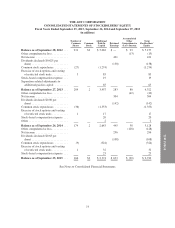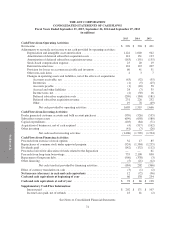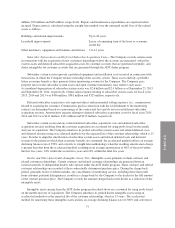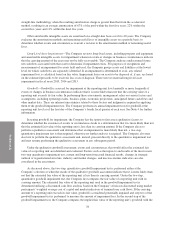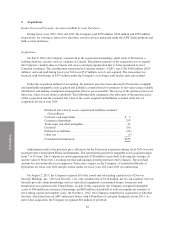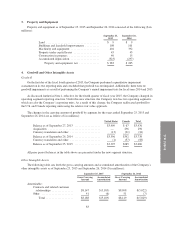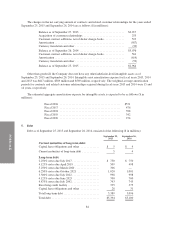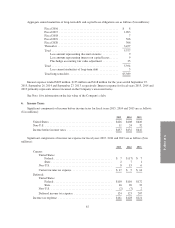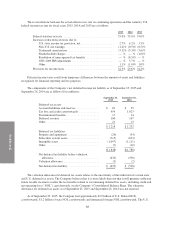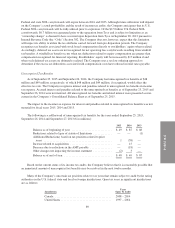ADT 2015 Annual Report Download - page 154
Download and view the complete annual report
Please find page 154 of the 2015 ADT annual report below. You can navigate through the pages in the report by either clicking on the pages listed below, or by using the keyword search tool below to find specific information within the annual report.
FORM 10-K
its estimate of whether, and the extent to which, additional taxes will be due in accordance with the authoritative
guidance regarding the accounting for uncertain tax positions. These tax liabilities are reflected net of related tax
loss carryforwards. The Company adjusts these reserves in light of changing facts and circumstances; however,
due to the complexity of some of these uncertainties, the ultimate resolution may result in a payment that is
materially different from the Company’s current estimate of the tax liabilities. If the Company’s estimate of tax
liabilities proves to be less than the ultimate assessment, an additional charge to expense would result. If payment
of these amounts ultimately proves to be less than the recorded amounts, the reversal of the liabilities would
result in tax benefits being recognized in the period when the Company determines the liabilities are no longer
necessary.
Concentration of Credit Risks—The primary financial instruments which potentially subject the Company
to concentrations of credit risks are accounts receivable. The Company’s concentration of credit risk with respect
to accounts receivable is limited due to the significant size of its customer base.
Financial Instruments—The Company’s financial instruments consist primarily of cash and cash
equivalents, accounts receivable, accounts payable, debt and derivative financial instruments. Due to their short-
term nature, the fair value of cash and cash equivalents, accounts receivable and accounts payable approximated
book value as of September 25, 2015 and September 26, 2014.
Long-Term Debt Instruments—The fair value of the Company’s unsecured notes was determined using
broker-quoted market prices, which are considered Level 2 inputs. The carrying amount of debt outstanding
under the Company’s revolving credit facility approximates fair value as interest rates on these borrowings
approximate current market rates, which are considered Level 2 inputs.
The carrying value and fair value of the Company’s debt that is subject to fair value disclosures as of
September 25, 2015 and September 26, 2014 is as follows ($ in millions):
September 25, 2015 September 26, 2014
Carrying Value Fair Value Carrying Value Fair Value
Long-term debt instruments, excluding
capital lease obligations and other ..... $5,361 $5,044 $5,065 $4,759
Derivative Instruments—All derivative financial instruments are reported on the Consolidated Balance
Sheets at fair value. For derivative financial instruments designated as fair value hedges, the changes in fair value
of both the derivatives and the hedged items are recognized currently in the Consolidated Statements of
Operations. The fair values of the Company’s derivative financial instruments are not material.
During the year ended September 26, 2014, the Company entered into interest rate swap transactions to
hedge $500 million of its $1 billion, 6.250% fixed-rate notes due October 2021, and all $500 million of its
4.125% fixed-rate notes due April 2019. During the year ended September 25, 2015, the Company entered into
interest rate swap transactions to hedge all $300 million of its 5.250% fixed-rate notes due March 2020. These
transactions are designated as fair value hedges with the objective of managing the exposure to interest rate risk
by converting the interest rates on the fixed-rate notes to floating rates. These transactions did not have a material
impact on the Company’s Consolidated Financial Statements as of and for the years ended September 25, 2015
and September 26, 2014.
Restructuring and Other Charges—During the year ended September 25, 2015, restructuring and other charges
were not material. During the year ended September 26, 2014, the Company recognized $8 million in severance
charges related to the separation of employees in conjunction with actions taken to reduce general and
administrative expenses, $6 million in charges primarily related to a loss on the sublease of a portion of its office
space and $3 million of other costs associated with consulting services focused on identifying actions to reduce its
cost structure and streamline operations. Substantially all of these charges were paid as of September 25, 2015.
80





